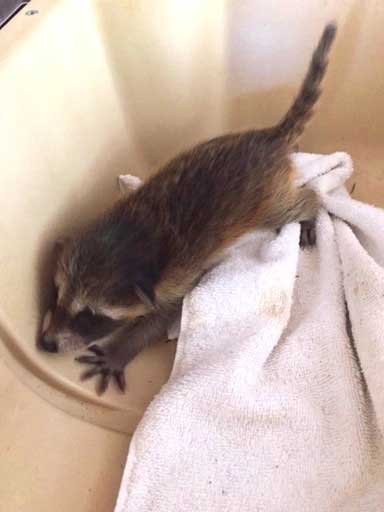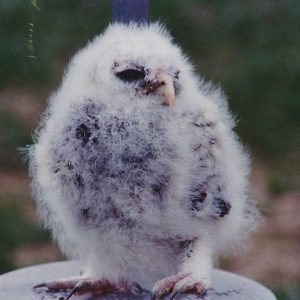As we’ve done for several years, this month’s column is a reminder from Don Cote at the Duck Pond Wildlife Rehab Center that not all young animals that appear lost or orphaned actually need to be rescued. Despite people’s good intentions, some babies do not need human involvement other than careful observation. Again, I’m going to honor Carleen Cote by sharing her words of wisdom from many decades of wildlife rehabbing:

Baby raccoon at Duck Pond Wildlife Center, by Jayne Winters
“With the return of warmer days, our feathered friends are returning from their southern hiatus, and native wildlife are becoming more active. This is an appropriate time for a reminder about whether or not young wildlife that appear to need rescuing really need human intervention.
“White-tail fawns are often rescued when they should be left where they were found. A very young fawn will not move until given a signal from its mother. It has no odor, so if it is found by a dog, coyote, or other potential predator, it’s by accident, not from a scent. The doe does not remain with her fawn(s) at all times; she leaves to feed herself and may not return for several hours.
“If you’re walking in the fields and woods and spot a fawn, don’t immediately assume that it needs to be rescued. Mark the spot where it was seen and leave; return after a few hours or the next day. If the fawn is in the exact same spot, it’s probably safe to assume something has happened to the doe. Contact a game warden or rehabber and follow the advice given.
“If you find a young bird on the ground and no nest is found, make a substitute from a berry box or basket; be sure there are holes for drainage and hang it in a tree close to the spot where the bird was found. The adults will respond to the feeding calls of their youngsters. If cats are prowling or stalking birds, especially when there may be young birds in a nest that can’t survive without being fed, the cat should be confined rather than removing the birds. Fledglings — young birds that are feathered and out of the nest – need time to master the art of flying. Though they may spend time on the ground, this is not necessarily an indication they need human intervention. Observe whether there are adult birds flying around as they could be the parents, bringing food to the young or coaxing them to take their first flight.
“Of course, there are times when rescue is necessary such as when an adult female has died, but her young survive, or when young animals have been observed for some time with no adult arriving to care for them and lead them to safety. If you do rescue wildlife, as cute as they may be, bring them to someone who has the necessary permits and knowledge to give them a greater chance of survival. If you’re in doubt about the need to rescue any bird or animal, or have questions about the critters we enjoy and for which we are concerned, please call. We’re happy to answer any questions or advise you as to where you might get an answer.”

Owlet, from Duck Pond Wildlife archives
Don, Jane and Debbie are preparing for the busy weeks ahead and will continue to keep new admissions and potential long-term residents at a manageable number by transferring many rescues to other rehabbers who have generously offered to assist in their care. Please check this website for a rehabber close to you: www.maine.gov/ifw/fish-wildlife/wildlife/living-with-wildlife/orphaned-injured-wildlife/index.html or contact your local Animal Control Officer through your town office.
Donald Cote operates Duck Pond Wildlife Care Center on Rte. 3 in Vassalboro. It is a nonprofit, State-permitted rehab facility, which is supported by his own resources and outside donations. Mailing address: 1787 North Belfast Avenue, Vassalboro ME 04989 Phone: (207) 445-4326. Please note that the prior wildlifecarecenter email address is no longer monitored.
—by Jayne Winters, Natural Resources Council of Maine member from South China, Maine
Critter Chatter also appears monthly in the Town Line newspaper.














Leave a Reply